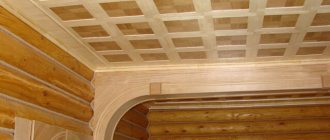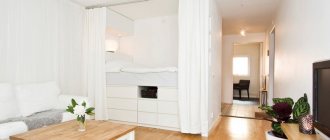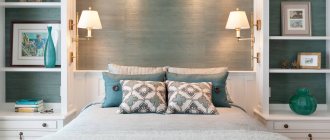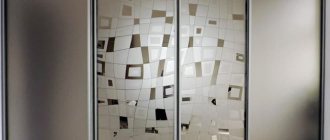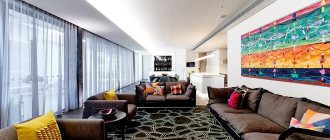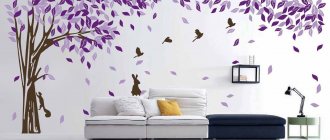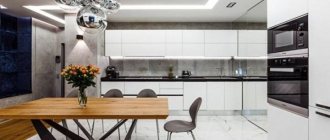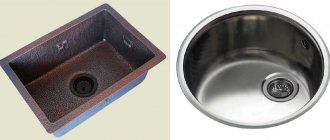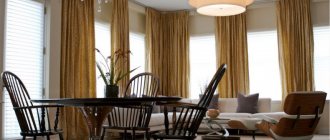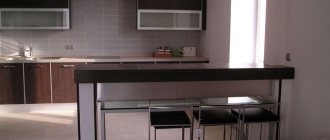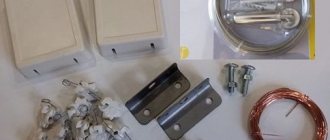Obvious joints in wallpaper are, in general, normal. Wallpaper is not a solid covering, so seams cannot be avoided. But I would, of course, like the joints not to be too flashy. Some people think that very visible seams give the walls an untidy look. Some perceive them as a sign of poor quality repairs. For perfectionists, these lines can simply make them nervous.
Noticeable joints mean different things. These could be, for example, gaps between wallpaper sheets. In such a situation they also say that the wallpaper has come apart. These may be darker or lighter stripes in the seam area. And it happens that the joints are simply noticeable, although there are no cracks, no stains, no difference in shades.
The reasons for this phenomenon are as varied as the forms of its manifestation. Let's consider common situations.
Significant shrinkage of wallpaper
This causes the joints to widen, making them visible. The base surface of the wall may be visible between the sheets.
If the wallpaper and the wall are approximately the same color, the seams will not be so obvious. Another thing is when the base and wallpaper are contrasting in relation to each other. If the seams of dark wallpaper pasted on a light surface expand, rhythmic light stripes will appear on the walls (they can be disguised by tinting the wallpaper with watercolors, pencil, chalk, etc.).
Why do the wallpapers diverge? The reason may be due to incorrect gluing technology: not all wallpaper can be wetted too much.
If the wallpaper label states that the adhesive should only be applied to the wall, that’s exactly what you should do. If, according to the instructions, the glue must be applied directly to the wallpaper, do not allow it to become excessively wet.
It happens that gluers, wanting to optimize time costs, resort to the “rational method”: they cut many sheets at once and immediately coat them with glue, folding the edges towards the middle. And then they start gluing one canvas after another. When the turn comes to the third sheet, it is already excessively wet. There is nothing to say about the subsequent ones.
When drying, wet wallpaper noticeably shrinks, shrinkage occurs, and the joints expand. Similar processes can occur if an excessive amount of glue is used to lubricate the wallpaper.
Another mistake that leads to widening of joints is due to inexperience. The new wallpaper sheet should be immediately applied close to the pasted sheet - end-to-end, neck to neck. Beginners often leave a gap and then stretch the canvas to the edge of the adjacent sheet. Stretched wet wallpaper shrinks significantly when drying, which leads to seams coming apart.
The next potential culprit is a draft. Drafts should not be allowed to appear during the pasting of walls and for some time after completion of the work. A draft can cause wallpaper sheets to dry too quickly. They will begin to shrink before they have time to stick firmly and reliably to the wall, which will negatively affect the joints.
The result often depends on the wallpaper itself. Some shrink significantly, even if all the basic rules and recommendations from the instructions were followed when working with them. To avoid buying such capricious wallpaper, you should study the reviews if possible.
Light edge of dark wallpaper
For wallpaper, only the top layer, the front layer, is painted. The base of the canvas is always white. Few manufacturers paint the ends - most often they are also white.
When dark wallpaper dries and shrinks slightly, the white end of the wallpaper becomes visible. As a result, the wallpaper receives a vertical white stripe. It is usually quite thin, but can be noticeable, creating an accent on the seams.
Some manufacturers share this information in the wallpaper instructions: they warn about the possible appearance of this effect and give recommendations for masking. For example, it is recommended that after the wallpaper has dried, paint over the white end lines with pastel chalk to match.
Master painters have their own secrets: some use a thin brush and watercolors, others use colorants. Some people “retouch” with felt-tip pens, while others use gel pens. The main thing here is to successfully choose the shade. Therefore, it is first worth conducting several tests in those areas that will subsequently be covered with furniture or curtains.
You can paint over the edges before gluing the sheets. Masters also practice this. In this case, the coloring must be moisture resistant.
Heterogeneity of wallpaper shade
It happens that the tone of the canvas changes slightly from edge to edge. This may be completely unnoticeable until the wallpaper is on the wall. If there is a difference in tone, the joints will stand out.
This is from the category of optical illusions. It is known that the same shade is perceived differently on a dark and light background. A dark shade, next to a light one, seems darker than it actually is.
If we connect a slightly darker edge with a lighter one, clearly visible contrast stripes appear.
Such wallpaper should have an icon: a reverse (or counter) sticker. This means that each subsequent sheet must be glued in the opposite direction in relation to the previous one. That is, we glue the first sheet as usual, and turn the second one 180 degrees (“upside down”). We glue the third like the first, the fourth like the second. If the tone is uneven, a counter sticker will help avoid sharp changes in tone with noticeable stripes along the seams.
On the left is a sticker in one direction; on the right is the oncoming one.
However, it happens that there is a difference in shades, but the icon about the reverse sticker is missing. Therefore, it is always advisable to start work by gluing three sheets on an area that will subsequently be completely or partially hidden (behind furniture, curtains, doors or decor). Let these three sheets dry and evaluate the result. If it turns out that the shades at the edges of the wallpaper are different, you should try a counter sticker.
By the way, if there is a difference in tone, and there are no special instructions in the instructions, this can be regarded as a defect in the wallpaper. The buyer has the right to issue a return and receive money back.
Traces of gluers' diligence
Trying too hard can backfire. As in a children's riddle: “Three, three, three - it will be... No, not nine, but a hole.” Of course, it is unlikely that you will be able to rub the wallpaper to the hole, but traces may remain.
Someone wipes the glue off the front surface too hard. Someone smoothes and presses the edges with excessive pressure or carefully rolls them with a roller. This can destroy and crush the wallpaper texture at the junctions of the panels or partially erase the paint from the top layer. As a result, these areas will become different.
Even the instructions for wallpaper often write that you should not apply excessive force. Manufacturers also often do not recommend rolling with a roller.
Wallpaper formally without selection, but with selection
Unfortunately, this happens. At first glance, if you unroll the roll, no selection seems to be required. Especially if the wallpaper is plain, without a pattern. There is no word in the instructions about fitting, there is no corresponding icon. But after sticking, the wallpaper presents a surprise: it does not look like a solid covering, each sheet stands out clearly. Why? Because, for example, the relief varies and does not match from sheet to sheet.
Before gluing wallpaper with a texture, especially a complex one, you should make sure that they really do not require matching. The sheets should be placed next to each other on the floor or table. But even in this case, you may not be able to see the nuances that will become noticeable on the wall. Therefore, it is advisable to carry out a test gluing of three sheets and evaluate the result after drying (from different angles).
Uneven wallpaper edge
This is a defect or a consequence of rough transportation and improper storage. The hands of the gluers have nothing to do with it.
The wallpaper should have a perfectly smooth, clear edge. Not deformed or crushed. It should not look as if the paper was cut with a dull knife. Wallpaper with poor edges will not produce perfect joints.
Before paying for the wallpaper you like, you need to carefully examine the edges of the samples. And also make sure that the integrity of the packaging of the issued rolls is not compromised.
Failure to comply with transportation and storage rules can lead to contamination of the edge. If the wallpaper is light, it will definitely be noticeable on the wall.
Overlapping
If one canvas slightly overlaps another, a slight thickening occurs. The joint protrudes as a tubercle and makes the seam noticeable. Wallpaper cannot be glued overlapping.
Traces of glue
They may not show up on light or patterned wallpaper. But the darker the wallpaper, the more noticeable the glue. The joints become whitish and hurt your eyes.
Moldings and borders
An excellent idea is to frame an unsightly junction of materials using overhead convex strips - moldings, borders. Such products are independent decorative elements, but can also serve as a means of masking various flaws.
As a rule, moldings are used to separate the decoration in a classic interior, more often in a horizontal plane. Simply put, if the lower part of the wall is covered with one material, and the upper part with another, then a dividing strip-molding is laid between them. The simplest example is companion wallpaper pasted across a border.
Stucco moldings and moldings in the interior
If you decide to join materials vertically, then the use of moldings is not recommended. The latter will rest against the ceiling, where they will also have to be somehow combined with the baseboard. But moldings and borders are suitable for framing the wall, which will distract attention from the joint and serve as additional decor for the room.
To avoid problems, stick to the right technology
Before you begin repairing and decorating walls yourself, it is important to know and follow the correct technology for all of the above work. When cutting wallpaper, make sure that the individual parts of the design or pattern match; to do this, use a pencil and a well-cutting utility knife. Consider the distance to the ceiling from the top edge of the wallpaper. To avoid darkening and yellow spots on the wallpaper, try to use only high-quality glue. When gluing, also monitor the room temperature - avoid sudden changes and drafts.
Sealant
This tool is suitable for eliminating a joint if the edges of two materials fit perfectly together and their texture is similar. In such a situation, you can make the joining line invisible using a sealant of a suitable color or a transparent composition.
Important! The sealant is best suited for combining tiles, mosaics, porcelain tiles, and panels.
Sealing the joint with sealant
It can be used even in damp rooms. True, it will have to be replaced periodically, since the service life of the material is only 2-3 years.
Necessary equipment to correct overlap on wallpaper
In order to fix seams, a split joint between wallpaper, a dark and yellowed defect, wear or stain, the following tools are needed:
- A patch on which there is an element of the design that falls on the joint;
- Ribbon, cord, decorative edging or wallpaper border to radically eliminate an uneven joint or disguise it;
- Glue (even PVA will do);
- Scissors or stationery knife and pencil;
- Brush or sponge;
- Roller;
- Soft sandpaper;
- Water;
- Unnecessary wallpaper trimmings;
- Coloring paste.
Decorative sides
Typically, such sides are used to decorate walls with 3-D panels along the entire perimeter or along the sides. The sides are matched to the color of the main coating, but can also be contrasting.
Such elements are well suited for joining panels with other materials. The junction will look more aesthetically pleasing and neat. There are sides of different widths on sale, and the widest of them can serve as independent interior decor.
Edge for table top
Required Tools
In addition to the wallpaper itself, you will need many more tools and other little things:
- Bucket . It will be needed first. It is most convenient to mix the glue in a bucket. Please note that if you do not plan to use the glue today, you should purchase a bucket with a tight-fitting lid. This is the only way to preserve the properties of the glue.
- Glue tray . Choose a bath that matches the size of the roller. The bath should be a little wider.
- Paint roller . With its help, the glue is distributed on the back side of the wallpaper that you plan to glue, or applied to the wall.
- Wallpaper roller . Don't confuse it with the aforementioned roller, they are completely different. A wallpaper roller is needed to smooth the surface of the wallpaper after gluing. This will help get rid of unwanted bubbles and excess glue protruding between the seams.
- Wallpaper roller for corners . Thanks to its convenient shape, it will easily help you apply the necessary pressure on the corner areas of the canvas.
- Special wallpaper scissors . If you have regular household scissors at home, but sharp ones, you can use them.
- Sharp knife . It is needed so that you can cut the corner joints. A regular stationery knife is best suited for these purposes.
- Rubber spatula . It is needed to level the wallpaper.
- Clean rags . They are needed to wipe off glue from wallpaper. You can also use a regular sponge, but only the soft side. Never rub the wallpaper with the hard side, as you may damage it.
- Large table with a flat surface . If you do not have such a table, then the floor can easily replace it. True, it is not so convenient.
- Ruler . It is advisable to have a construction ruler, but if you don’t have one, then a regular one will do.
- Construction tape . It is needed to measure the height and width of the walls. It will also help to cut the wallpaper correctly.
- Painting spatula . It is very convenient to use when you need to trim wallpaper near the ceiling or floor. In this case, simply place a spatula there and cut the line with a knife.
This is a list of just the basic tools that you will definitely need for wallpapering.
Eliminating the difference
It happens that the joint of materials looks very ugly, since they have different thicknesses (for example, wallpaper and decorative plaster). If coatings of different textures do not lie in the same plane, you need to think about leveling at the repair stage.
Advice! The best solution is to bring them to one level using drywall, which “increases” the missing thickness of the fragment.
In this case, the part of the wall with a thin finish will not look like it has failed. If desired, more complex structures can be erected from plasterboard at the joint, although you can simply screw a sheet of the required thickness to the wall.
Fighting the edges that have risen up like a house
Not the most difficult, but quite common case when joints rise and twist, photo. Usually craftsmen in such a situation, in order to hide their imperfections, blame the quality of the wallpaper and poor glue. In fact, the problem lies precisely in the lack of professionalism of the workers. In the process of coating the cloth, experienced craftsmen apply glue to the edges twice, because the adhesive mass dries much faster along the edge of the cloth. To hide the raised joints, just apply an additional layer of adhesive under the seam line and roll the trellis with a rubber roller.
It is much more difficult to hide a defect at the joints in a situation where the seams have risen along with pieces of soil and whitewash. This means that the preparation of the wall surface was carried out extremely carelessly, and when shrinking, the wallpaper tore off the adhesive seam at the joint. In this case, you have to spend a lot of time soaking and removing the old glue from under the joint, and only then gluing and rolling the fabric. If you try to re-glue the seams as they are, the remnants of the old glue and whitewash will make the seam stand out, and under certain lighting the defect will appear in a new way.
"Artistic junction"
Oddly enough, careless design visually blurs the boundaries of the finish, making it seem to flow into the boundaries of a material with a different texture. A good example is a fresco or painting: it can not be highlighted with a frame, but, on the contrary, the edges can be made “torn” and poorly processed. An uneven border of a stone finish will also look more harmonious against the background of wallpaper or a painted surface than a coating with clear contours.
Lighting and furniture
Often, well-chosen lighting allows you to visually mask the difference in planes. For example, when the perimeter is illuminated from the inside, a volumetric panel will successfully merge with the surrounding surfaces, and the junction of materials will become natural and logical.
In addition, the border of different textured finishes can be successfully hidden with furniture. The easiest way is to hang shelves and install an interesting rack. When connecting vertically, you can install a built-in cabinet in the problem area.
Cork compensator
Another way to achieve a smooth transition from one type of coating to another is to use a cork expansion joint. It has a number of advantages:
- environmental friendliness and, as a result, safety;
- possibility of tinting to match the color of the coating;
- elasticity, thanks to which it can easily cope with the expansion of the laminate over a small area;
- durability, subject to proper installation and varnishing.
In modern minimalist interiors, cork expansion joints are also used to finish the floor-wall joint, replacing the usual baseboard.
What to do with joints in corners?
Sometimes the border between two different materials passes in the corner of the room. Without the use of additional decorative techniques, the corner area looks sloppy and the border looks crooked. There are several options to resolve this issue:
- Joint offset. This solution is implemented at the repair stage. The boundary between the materials is moved to the wall, for example, they make plaster cladding a little further than the corner (2-3 cm). In this case, the joint will look less uneven, and the unusual technique will draw attention to itself.
- Introduction of transition material. The narrow space in the corner area is decorated with a material similar in color and texture, which can be applied in an even layer. For example, on the sides of a textured plaster finish, strips of microcement of the same shade are applied and the corners are perfectly aligned with it.
- Side or molding. The wall, finished with an accent coating, is decorated in the corners with sides of the same thickness. The products will serve as a kind of frame and make the corner joints aesthetic.
- Color to match. If the textures of two materials are very different, you can paint them the same color or immediately select coatings that are similar in tone. An ideal example is a combination of a painted wall and paintable wallpaper.
Defect options
Most often, owners blame both the craftsmen and the quality of the wallpaper. But if the craftsmen are professionals, and before this room they managed to glue kilometers of canvases with high quality without any comments, why did they not take into account the peculiarities of the brand of trellis when gluing. Indirect confirmation is the fact that the same problem occurs with both cheap paper and expensive non-woven wallpaper.
The answer to the question of how to make wallpaper joints invisible does not have a clear answer, since the defect itself at the joints can manifest itself in different ways:
- The neighboring canvases have separated, and a thin gap has formed through which the wall is visible;
- A lighter or darker uneven strip of glue residue appeared along the joint;
- The joints at the border of the wallpaper have risen like a “house”;
- At the joints, the difference in shades of the two canvases is clearly visible.
The last point is the most unpleasant. It often happens that when buying wallpaper in a company store, you can purchase rolls from the same manufacturer, the same brand, but belonging to different batches. To sell mismatched items and make the product attractive, salons collect leftover rolls from different batches into one and sell them at a slightly reduced price.
Many manufacturers, due to the peculiarities of the technology for applying paints to the panel, are not able to ensure ideal distribution of the toner; as a result, one edge turns out to be slightly darker and more saturated than the other. It is impossible to hide such a defect, so an icon with two vertical arrows directed in different directions is placed on the roll. This means "reverse sticker sequence". To hide uneven coloring, each subsequent roll must be turned 180 degrees before cutting and gluing. If you do not pay attention in time to the icon hidden in the text of the marking, the discrepancy in shades at the joints can only be corrected by painting the trellises.
Joints of materials between walls and ceiling
The combination of contrasting materials for walls and ceilings often looks unsightly. The relief finish, which ends abruptly under a smooth, even ceiling, looks especially unaesthetic.
You can solve the problem in different ways:
- painting the walls and ceiling in the same tone;
- placing wall material on the ceiling in the form of a narrow strip, or painting the upper part of the wall with ceiling paint;
- construction at the junction of a small side;
- using successful ceiling cornices.
Obtaining an aesthetic junction of different materials is an important task for the designer when arranging the interior. If you ignore it, it is almost impossible to achieve an ideal result and a harmonious appearance of the room, so it is worth thinking in advance about possible solutions to the problem, and then putting them into practice!
Docking profile
The most traditional way of connecting two finishing materials on the floor is a joining profile.
It is almost irreplaceable when tiles are adjacent to a “floating” floor. Laminate, and sometimes parquet, do not have an adhesive connection to the base. When laying such materials, it is necessary to leave compensation gaps for the natural expansion of the board. The T-shaped profile completely hides the joint, connecting the floating and hard floors. A significant disadvantage of this type of fastening is its visibility. Despite the fact that manufacturers offer compact brass, aluminum and plastic profiles in a variety of shades, it is still not possible to completely disguise the joint. If you can’t find the most inconspicuous option, you can support the shade of the profile with other interior accents in color.
